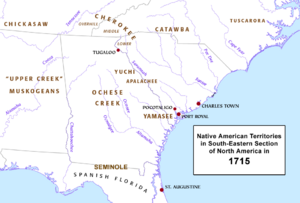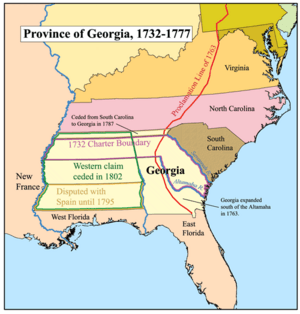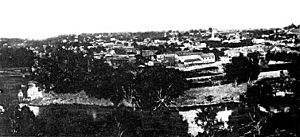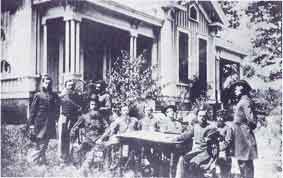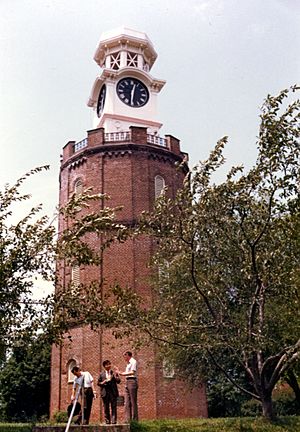History of Rome, Georgia facts for kids
The history of Rome, Georgia goes back thousands of years. Ancient Native American groups lived here long before anyone else. Spanish explorers first visited the area in the late 1500s. Later, in 1834, American settlers founded the city of Rome. At that time, many Cherokee people still lived there. They were later forced to leave their homes on the Trail of Tears.
Rome grew because it sits where three rivers meet. This made it a great spot for trade and travel. The city became the main town, or county seat, of Floyd County, Georgia. Today, Rome is the biggest city in Northwest Georgia. It is also a major center for healthcare, schools, and making things.
Contents
Ancient Native American History
People from the Mississippian culture lived in the Rome area around the year 1000 CE. They built large mounds and had complex societies. Sadly, many of these people likely died in the late 1500s. This was due to new infectious diseases brought by Spanish explorers. We don't have written records from this time. But we learn about these cultures from old artifacts and language studies.
Historians believe that Hernando de Soto and his Spanish team explored this region in 1540. Later, in 1560, another Spanish group led by Tristán de Luna traveled north. They became friends with the Coosa chiefdom. They even helped the Coosa in a fight against another group.
Within 20 years, the original mound builders were mostly gone. The Creek people then moved into the area.
The Abihka tribe of Creek Indians lived near Rome. They later joined other tribes to become the Ulibahalis. They eventually moved west into Alabama. By the mid-1700s, the Cherokee people had settled in the area. They were pushed here by European-American settlers moving onto their lands.
In the 1700s, there was a big demand for deer skins in Europe. This led to a busy trade between Native American hunters and white traders. A Cherokee village called Chatuga was built near the Coosa River. This happened after the Cherokee moved west during the Cherokee–American wars (1776-1794).
Several important Cherokee leaders lived here, including Major Ridge and John Ross. They even had large farms. Today, Major Ridge's house is a museum called the Chieftains Museum (Major Ridge Home). It is a very important historical site.
The Cherokee allowed some white traders and settlers to live and trade in the "Head of Coosa" area. After the American War of Independence, more settlers arrived. They came from the British Colonies of Georgia and Carolina.
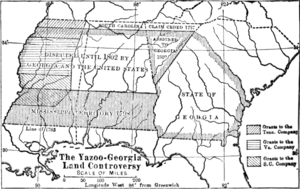
After the war, the United States gained control of lands west of the Appalachian Mountains. This land was previously set aside for Native Americans. Soon, American settlers began moving onto Cherokee lands. In 1802, the state of Georgia and the United States made an agreement called the Compact of 1802. Georgia sold its western land claims to the U.S. In return, the U.S. agreed to remove all Cherokee people from Georgia.
However, this promise was not kept right away. Through the 1820s and 1830s, Chiefs Major Ridge and John Ross tried to stop the removal. They even filed lawsuits in federal courts.
During the Creek Civil War in 1813, most Cherokee sided with the Upper Creek Indians. Chief Ridge led a group of Cherokee warriors. Chief Ross was also part of this group. They fought under Major Andrew Jackson.
In 1829, gold was found near Dahlonega, Georgia. This started the first gold rush in the United States. The gold discovery, along with President Andrew Jackson's strong support for removal, led to the Indian Removal Act of 1830. This act aimed to fulfill the Compact of 1802. In 1831, Georgia quickly claimed all Cherokee land in Northwest Georgia. This entire area was called Cherokee County. In 1832, it was divided into the nine counties we know today.
Founding the City of Rome
In 1834, several important men founded the city of Rome. They were Col. Henry Thomas McCool, Col. Zachariah Branscome Hargrove, Maj. Philip Hemphill, Col. William Smith, and Mr. John Lumpkin. They decided the city's name by drawing from a hat. Col. Mitchell suggested "Rome" because the area had hills and rivers, like the famous city in Italy. His choice was picked. In 1835, the Georgia Legislature officially made Rome a city. The county seat was then moved from Livingston to Rome.
Rome During the Civil War
In April 1863, during the U.S. Civil War, Confederate General Nathan Bedford Forrest defended Rome. He stopped Union Colonel Abel Streight's raid. General Forrest tricked Colonel Streight into surrendering close to Rome.
Realizing the city was vulnerable, Rome's leaders spent money to build three forts. These forts were ready by October 1863. They were named after Roman soldiers who had died in battle. Fort Attaway was on the west side of the Oostanaula River. Fort Norton was on the east side. Fort Stovall was on the south side of the Etowah River. Another fort was later built north of the Coosa River.
In May 1864, Union General Jefferson C. Davis attacked and captured Rome. The Confederate soldiers, led by Major General Samuel Gibbs French, had to retreat. Union General William Vandever was stationed in Rome. Rome was an important military target. This was because of its forts and iron works, which made cannons.
Davis's forces stayed in Rome for several months. They fixed the damaged forts. General William Tecumseh Sherman even stayed there briefly. On November 11, 1864, Union forces destroyed Rome's forts and iron works. They also ruined the rail line to Kingston and anything else that could help the South's war effort. They then left Rome to join Sherman's March to the Sea.
Rebuilding Rome After the War
In 1871, Rome built a water tank on Neely Hill. This hill overlooks the downtown area. This water tank later became the famous clock tower. It has been a symbol of the town ever since. It even appears on the city's crest and business logos. Because of the tower, Neely Hill is also called Clock Tower Hill.
Rome is located where two rivers meet to form a third. This means it has sometimes faced serious flooding. The first major flood after Rome became a city was in 1886. The flood covered the city, and a steamboat could even travel down Broad Street!
In 1891, the state of Georgia changed Rome's city rules. They created a group to build river levees. These levees would protect the town from future floods. In the late 1890s, more flood control was added. This included raising Broad Street by about 15 feet. Because of this, many of the basements in Rome's old buildings were actually the original ground-level entrances.



